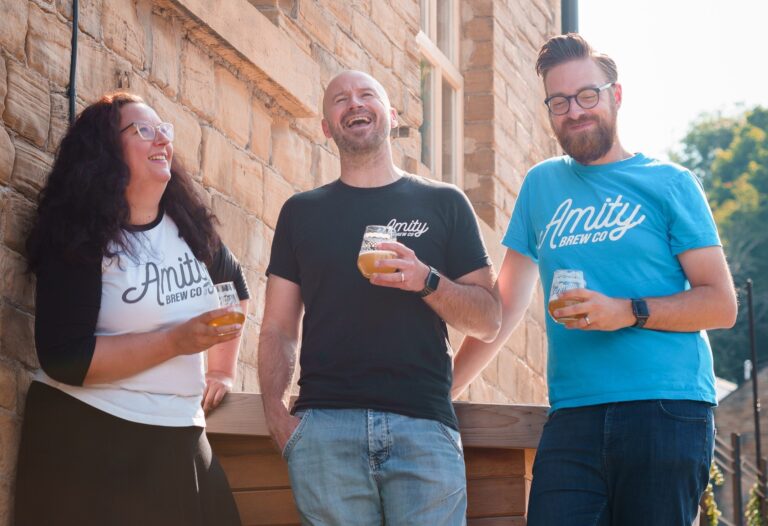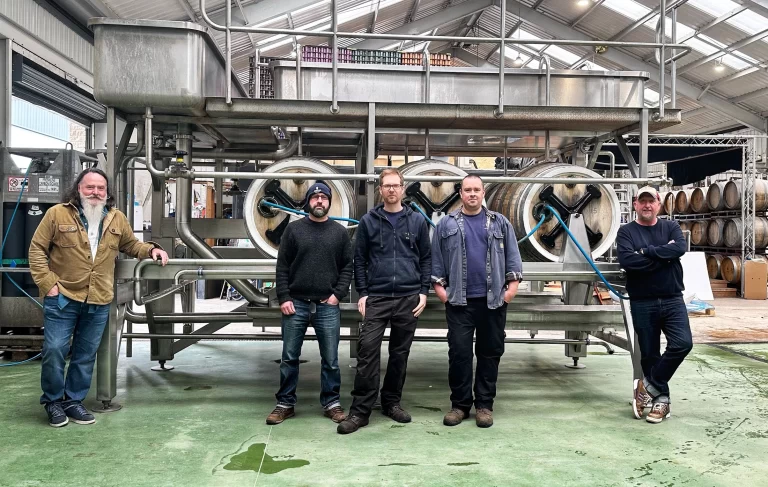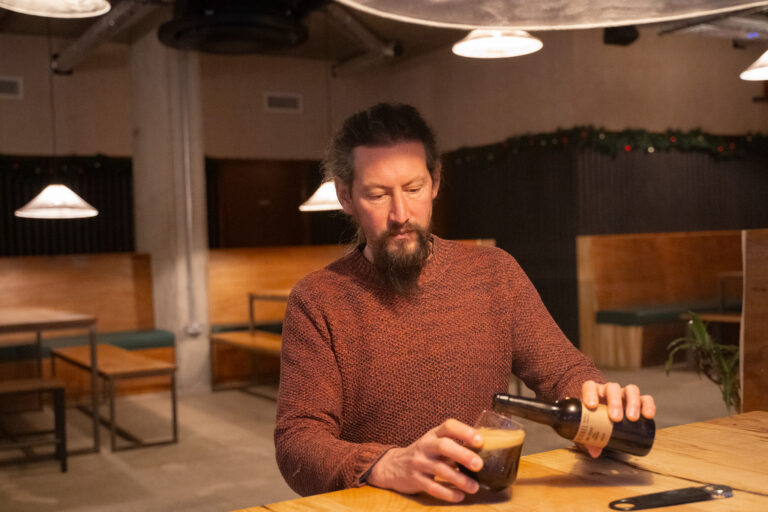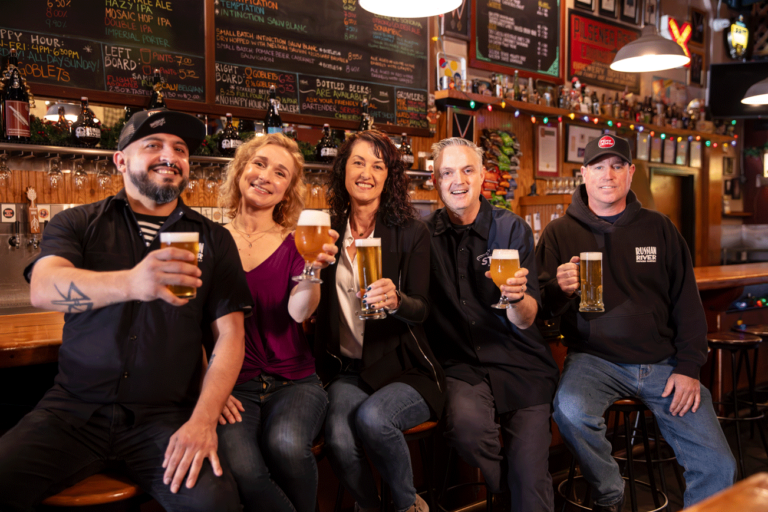There is more to African beer than cold, fizzy lager. Much more. Here, Kieran Aylward takes us on a journey through Kenya, Tanzania and Zambia to discover a world of innovation, invention and ingredients.
For most, probably all, a journey into Africa will indelibly stamp the travellers’ psyche. It will leave them with a kind of pre mature nostalgia, yearning for the continents addictive character even before they have left it.
It could be for the damp smell of the smouldering fires producing charcoal, or the sight of bicycles groaning under an impossible weight bringing that carbon residue, slowly, from the bush towards the towns.
The view of water rising, smoke-like into the atmosphere from one of the continents great waterfalls. The sound and sensation of a grunting hippo. The big fish at the end of a line stretching into a terrifying abyss.
The warm Indian Ocean lapping at your weary feet. But perhaps universally, the taste of an ice-cold, factory-produced beer at the end of a hot, dusty and exciting African day. The dripping bottles are labelled with names like Tusker, White Cap, Summit, Mosi oa Tunya, Serengeti, Ndovo and Kilimanjaro.
But if the names are diverse, the beer really isn’t. With the exception of some rare outliers like Bia Bingwa, a 7% powerhouse from Tanzania, all are light and pilsner-esque, at or near 4% and fizzy. (Actually, there some examples that inconveniently disrupt this narrative, like the Namibian beer Windhoek, brewed in Windhoek and following a regime close to the German purity laws. But let’s leave those for another day)
It’s strange that, even for the most orthodox craft beer follower, the uninteresting nature of the beer itself detracts nothing at all from the joy of its consumption – if consumed in the rightful setting.
It’s common to hear IPA producers from all over the world talk about how a high bitterness and ABV helped the beers of the past stay fresh on their journey to the tropics.
The implication is that the beer was drunk in the form that it travelled, but for anybody used to drinking beer in the tropics, it seems more likely that these IPAs were destined for dilution. But perverse as it seems, there is evidence that strong beer was enjoyed in the heat. Winchester Cathedrals grave yard has a tombstone which seems to support this. It reads;
“In Memory of
THOMAS THETCHER
a Grenadier in the North Reg
of Hants Militia who died of a violent Fever contracted by drinking Small Beer when hot the 12th of May 1764. Aged 26 Years.”
And it goes on to offer what seems like bad advice;
“Here sleeps in peace a Hampshire Grenadier,
Who caught his death by drinking cold small Beer, Soldiers be wise from his untimely fall And when ye’re hot drink Strong or none at all.”
But African drinking culture is far richer than purely the satisfyingly homogenous beers produced by brewing titans like SAB Miller, AB InBev and Diageo. Long before commercial brewing began, indigenous beers were brewed and consumed for all the same social and cultural reasons that beer still enhances today.
You won’t find indigenous brews in the hotel bar, so to learn more you would need to find an insider, somebody like Chaka Maina. Born in Nairobi and schooled in Tanzania and the UK, Maina is now a full-time banana farmer. To find him you need to try two places, the first being his farm on the river Sagana, a tributary to the mighty Tana.
The second being one of his watering holes in Nairobi. Maina is a Kikuyu, one of the 42 or so tribes in Kenya and the largest tribe in terms of number. So while he is no stranger to the big Kenyan beer brands, Tusker and White Cap, he is also a connoisseur of the traditional Kikuyu brew Muratina.

Muratina is the name in Kikuyu of Kigelia africana, or the Sausage tree, whose fruits are used to make the brew. As well as being the main ingredient in Muratina, the tree, or parts of it, have numerous other medicinal uses.
This leads most drinkers to, logically, conclude that the brew itself is something of a health tonic. It’s traditional that the fruit used to make the brew should be those gathered from the ground, and not those hanging on the tree, and it seems wise to follow the rules.
Murtatina fruit is said to be poisonous and cause blisters when inexpertly prepared. However, Chaka suggests that the risk could be exaggerated to protect the jobs of the brewers.
The fruit is cut and left to dry in the sun. It is then boiled before being added to honey or sugar cane juice. The pieces are removed and dried again before being added back with more honey or cane juice.

Fermentation takes between one and four days depending on how strong you like your Muratina, and then served, as you may guess, in a cow horn. Not only is the cow horn a show of the Kikuyus agricultural prowess, it serves to moderate the dose.
Because of its shape, you can’t put down a cow horn, meaning its always in your hand – and so you have to keep drinking – enlivening the dance. Of course, eventually your Muratinamisted brain will misstep as you reach to rest the horn on a table, the ignominious spillage being your cue to call it a night.
Muratina is brewed mainly for ceremonial use like weddings but also for Ruracios – the traditional meeting of the inlawas, and Mugithi nights which is a kind of Kikuyu county music dance. But for a while its existence was under threat when it was caught up in a government drive to eradicate illicit alcohol.
The government drive started at a time when Kenyan politics was dominated by tribes other than the Kikuyu, making matters all the more complex. But given that the Kikuyu made up the majority of the Mau Mau freedom fighters who eventually won Kenya its independence in1963, the struggle for the right to brew by comparison probably seemed a fairly trivial skirmish.
In any case, the Kenyan constitution codifies protections for the cultures of all Kenyas tribes and no new law is allowed to undermine these protections, so eventually Muratina won the day. The victory is limited to brewing for ceremonial use so commercial brewing is still a grey area. So where does Muratina fit into the Ken yan beer scene?
Maina explains: “Kiyuys have a tradition of drinking alcohol, it’s sometimes said that coming from Nairobi at altitude (1,795 meters above sea level, 10th highest Capital city in the world) makes us harder to intoxicate. I’m not so sure about that, but it’s certainly true that a lot of Kikuyu enjoy a beer. And any kikuyu who drinks will have Muratina at least once a year .”
On his own relationship with Muratina he adds: “As youngsters, my friends
and I would travel to Kiambu, which is a village on the outskirts on Nairobi where some old guys made good Muratina.
We would sit eating Nyama Choma, (Barbeque goat) drinking Muratina and talking. Muratina played a big part in us connecting and continuing our Kikuyu traditions. Also, when I was married we had Muratina on the bar. We had plenty of Tusker, White Cap and wine too, but it was important that Muratina had a place.

The best selling beer in Kenya is Tusker, but on non-Muratina days Chaka prefers White Cap and a conversation on the subject exposes the aforementioned homogeneity of African beers to likely be an insensitivity to nuance.
“The other beers taste of chemicals but for me, White Cap is crisper. Also the other brews tend to be inconsistent during busier sales periods. They taste rushed and the yeast is incredibly prominent.” Chaka admits that having Mount Kenya on the White cap label helps too. Mount Kenya is an important place for the Kikuyu, where God lived when he came down to earth.
Craft beer has arrived in Kenya too, with brands like 254 Brewing, which brew all the styles you would expect to see in any UK taproom, Brew Bistro and Lounge whose beers have the names of the big FIVE (animals that charge) in Swahili, like Nyati (buffalo) and Simba (lion). But even with the new varieties, cold and fizzy, ac cording to Chaka, is still the order of the day. These comprise lagers and pilsners, with the occasional highly-carbonated “English ale”.
To Tanzania.
Chaka suggests another African brew, not Kenyan, but from his schooldays
in Arusha. You can get from Nairobi to Arusha in a number of ways, the quickest being to jump on a light aircraft at Nairobi Wilson Airport, but the most usual is the 5 hr (average) coach ride. Arusha is in across the border in Tanzania and is at the foot of Mount Kilimanjaro.
The brew is Mbege, a banana beer, brewed by the Chagga, a large ethnic (3rd largest) group native to northern Tanzania who are considered to be economically very successful, mainly because they are good agriculturists.

Where Muratina could be called a brew, it has no grain and would struggle to win the name “beer”, Mbege is brewed with germinated finger millet and so the translation to Banana Beer seems more apt. Mbege production is complex and very skilled, it involves aspects of malting, mashing and yeast propagation, all with wooden pots, calabash and an open fire.
The exact method is quite guarded, partly by secrecy, but mainly by geography and language. If you can’t get to the foothills of Kilimanjaro, and you don’t speak the worlds purist Swahili, you’re in the dark. Luckily, Chaka remembers some of the details.
It all starts with bananas, not commercial varieties like Cavendish (above) which Chaka grows, but varieties like Bokoboko, and Ndishi. Some of these bananas can be eaten when picked – like the ones on the supermarket shelf but some are starchy cooking bananas, others are suitable only for brewing.
The bananas are cooked until soft and porridge like, then left to cool and stored open to the air in wooden barrels until spontaneously fermenting Its a cross between a coolship and a sourdough starter.
Once fermenting, after around 10 days, this porridge becomes “Nyalu”, its quite low in ABV but with a high yeast (saccharomyces) and bacteria (lactoba cillus) cell count. Nyalu is a effectively an exercise in yeast isolation and propagation.
When the Nyalu is ready, it’s time to cook up some Mso. Mso is a mash made using germinated finger millet using a kind of decoction method. The millet is added to water and the constantly stirred mixture is heated.
Some liquid is drawn off and the remaining mash brought to the temperature range most brewers would recognise – lingering between 65 and 70 degrees C. After mashing, the liquid drawn off is added back, presumably to reduce viscosity. It’s then left to cool and then mixed with the Nyalu.

We now have Togwa, which contains all of the vigorous micro fauna of the Nyalu and the simple sugars of the Mso. The Mso was never boiled and so the enzymes in the millet will survive intact and will, like in a distillers mash, continue to be active during fermentation.
Consumption begins at the Togwa stage, where the alcohol level is low and the sugars high, balanced by the tart lactic acid excreted by the lactobacillus bacteria. After six hours or so the Togwa becomes Mbege, 3% ABV and still semi sweet. After 48 hours the ferment is at its terminal ABV of 4% and a gravity of 1.024.
This nomadic fermentation and the high finishing gravity are recurring features in indigenous brewing, where the imbiber is able to pick the brew by age based on whether they most desire ethanol or carbohydrate.
So far so intuitive for the craft brewer, but there is an interesting quirk in the Mbege method, and that’s the use of an adjunct called Msesewe. Msesewe is the bark of a tree called Rauvolfia caffra, or, the quinine tree. For a long time it was assumed, by the ignorant observer, to be just a flavouring.
To the expert native brewers, it was known to accelerate fermentation and recent studies have found that the tannins in the bark give an environment with a bias favouring the yeast and suppressing the bacteria, which indeed does give a faster and more complete fermentation.
We move East, to the Usambara Mountains.
To the east of Mt Kilimanjaro, in the Eastern Arc Mountains that run from the Kenyan border south through Tanzania, yet another brew is fermenting and that’s Pombe. “Pombe” is the Swahilli word for beer in general, but in this corner of East Africa it means only one thing – fermented palm sap.
Actually, fermented palm sap is common throughout the tropics, under names like Matango and Poyo elsewhere in Africa, Htan Yay in Asia and Tuba in Mexico, but the people of the Tanga region of the eastern arc have a particular fondness for it.
Pombe drifts back away from “beer” definition and towards the wine camp. The brewers of Pombe are arboreal, not terrestrial like a craft brewer. Where a craft brewer tends to their mash from the safe ty of the ground, or at the highest from a stainless steel platform, the pombe brewer works whilst tethered to the top of a palm tree. The Tapper collects the sweet sap of the tree which is so rich in wild yeasts that in the tropical heat it will begin fermenting almost immediately.
Tapping trees for sap might seem strange, but in the UK there is a tradition of tapping Birch trees to make a country wine. It makes you wonder what would happen if you left the sweet sap from Canadian maple trees in a warm place for a week or two.
The best way do describe the taste of Pombe is “variable”. Its another living fermentation, where the ABV changes in pack over time, but unlike Muratina and Mbege where the low yeast count gives a slow change, the rate with Pombe is rapid.
The taste goes from sweet, to funky/dry to compost/dry quite quickly. But like with most drinks, the flavour is not independent of the experience and setting. So as you relax in the East African sun under the shade of a thatched hut, chatting all things Pombe with company so experienced they have hand crafted pombe straws, the compost/funk line gets blurred as the day blurs into night.
On first glance in Zambia there seems to be a gulf between indigenous brewing and commercial brewing in Africa. But there are also instances where the gulf is breached. Indeed there are places where the global brewers are investing big in traditional African brews.
To find out more, Lusaka in Zambia is a good place to aim for. Lusaka is over 2000kms from the Usambara Mountains, but if you can get from the mountains south to Dar es Salaam (Dar), Tanzanias’ capital, the rest is pretty easy.
In 1970 the TAZARA railway was built to link land locked Zambia and its copper mines to Tanzania, its port and Capital Before the railway was finished, Zambias ore had to travel through Rhodesia and South Africa, which in the 1970s had governments who were unpopular – to say the least.
Zambian ore travels by road once again and the railway runs less reliably, but it will take you, over two to four days on average from Dar to Kapiri Mposhi, close to Lusaka.
Patience is a virtue, and al though slow, the ride into Zambia snakes through numerous national parks and the train canteen is, naturally, stocked with the omnipresent cold and fizzy factory brews. Zambia’s commercial beer is Mosi, short for Mosi oa Tunya the smoke that thunders.
That’s the old local name of the legendary Victoria falls, on Zambias southern border with Zimbabwe. The main traditional brew is called Um qumbothi, with the more modern name Chibuku. “Chibuku” is corrupted translation of “Little book” and a reference to the compulsive note taking by the first commercial brewers of Umqumbothi.
The biggest brand is Chibuku Shake Shake, which is what you need to do to homogenise the gritty brew, and it’s now owned by the SAB Miller/ AB InBev conglomerate, which demonstrates the con fidence there is in traditional beer growth.
But the SAB brand is not for everyone, the pasteurised and force carbonated brew has a shelf life previously unseen with Chibuku, and makes long distance logistics feasible, but sterility puts some customers off. This leaves a market for smaller brewers supplying fresh beer to a local market.
This include brewers like Pantelis Anastasio from Joma breweries with his Chibuku brand Waka Beer. Anastasio is from a Greek family, but hails from Zambia and studied in the UK.
When he travelled home after his studies he believed that traditional brewing was worth investing in. Joma is a small brewery by comparison to the SAB Miller but they are not playing around.
Joma have large fermentation capacity and modern equipment such as their centrifuge, which is used to reduce the heavy solid load in the ferment. It also needs to be a well organised affair, keep ing the beer fresh and unpasteurised removed the convenience of a long shelf life so an organised brewing schedule and a tight grip on logistics is essential.
Waka beer is popular, so Joma are busy and aren’t yet tempted to branch into making craft beer. Diversification in Africa is always on the cards however, and trials have started to distil a stronger version of the Waka beer. The distillate will be sold un-aged, like a new make whiskey. Who knows though, Pantelis may one day release Zambia’s first Bourbon.
Waka is packed in paper cartons but also delivered by tanker, which drives fully laden through the villages close to Lu saka making ad hoc deliveries as it goes.
These arrive in bulk to the makeshift taverns which are as common a sight in the villages as the churches; much to the long-gone missionaries’ dismay. The taverns are simple, and consist of a tin roof where the beer sits shaded from the harsh sun, and a few of the older drinkers can rest, but most drinkers sprawl into the countryside, drinking and chatting under the trees close to the tavern and listening to the tinny baseline of the tavern’s stereo.
Multiple cereals can be used to brew Chibuku, and as we get geographically closer to the bread basket of Africa, it’s now possible to find barley in the brew, where further north it wouldn’t grow.
But barley is expensive and usually finds its way to other industries and the most common cereals to use are Maize and Sorghum, with malted sorghum contributing the enzymes.
The investment from SAB miller has bought with it, indirectly, research by the likes of the Institute for Brewing and Distilling and the process that has been researched and documented is complex.
It starts with boiling sorghum and maize with lactic acid to gelatinise the starch at a low ph, then various steps of mashing, separation (by centrifuge) before fermentation.
Some accounts call for the malted sorghum to be added on two occasions throughout the brew. It can’t be that complicated in the villages where brewers still make Chibuku, and the complicated steps probably find efficiencies invisible to all but the huge brewers.

For a visitor, it’s all too easy to reach for the familiarity of the fizzy beer, and to shun the complicated and sometimes challenging flavour of the local brew.
And for several generations now, most Africans themselves have been familiar friends of the factory brews. But where these brews can offer consistency, shelf life and drinkability, it’s pleasing in an ever more unvaried world to see indigenous brews surviving.
It’s not hard to see why. Factory beer is expensive, and out of the daily reach for most of the continents’ rural people But like the mild drinkers of 1970s in industrial England, the African workers are drawn to the tavern and need something affordable when they arrive.
Factory beer, apart from copious C02 and some ethanol, is bereft of nutrition. Local beers can be alcoholic and attenuated too, but can also be high in carbohydrates and nearly as nutritious as a pint of porridge. The flip side is the low abv, making the no/lo movement in the west look like fairly old news.
Perhaps the the most interesting function of indigenous brews is how they reinforce cultural ties and traditions. As globalisation tries to smudge cultures together, brewing seems to be one last bastion of heritage.












